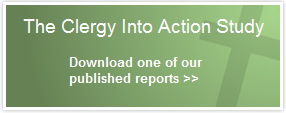Despite modest training in communication, newer clergy are nonetheless moderately confident in their own practice of communication arts. The large chart below shows the methods used by recently ordained pastors and priests—489 from the general clergy population, 305 alumni of Transition into Ministry (TiM) programs—to communicate core ideas and themes. The methods of communication have been arranged from the most frequently used to the least frequently used.
This chart shows remarkable similarity between the general population of clergy and the TiM alumni clergy who experienced intensive post-seminary development programs. Both groups reveal a range of communication strategies used to communicate core ideas. Newer clergy show an appreciation of the need for a multi-leveled approach to communication.
The chart reflects a pattern we previously found among more seasoned Episcopal priests: Clergy typically rely on their sermons as the first of the four primary means for communicating core ideas, in tandem with direct one-to-one communication, communication in the context of smaller gatherings and meetings, and repetition.
The art of joining these three key methods of communicating to the sermon helps ensure that an idea gets into the mind and discourse of a congregation. Beyond the high emphasis they place on these four forms of communication, recently ordained clergy also rely somewhat strongly on communication through email, printed materials, and in the context of pastoral encounters.
This is encouraging news. Recently ordained clergy show a finessed understanding of the need for communication in multiple ways and in diverse venues including small groups as well as with individuals—a balance more in keeping with the patterns of communication found in the preceding Higher Quality study among more effective Episcopal priests who served as positive change agents in their parishes.
In our earlier research with more seasoned Episcopal priests, we found that priests who were more effective change-agents relied most heavily on preaching, repetition, and in various small meetings to communicate core ideas and messages. In contrast, priests who were least effective, or were even negative change-agents, tended to rely almost solely on one-to-one contact, often in the context of pastoral care.1
But there is a limitation to note. Overall, these recently ordained pastors and priests rely most heavily on themselves (and other paid staff) as the source-point for communicating core ideas and themes. They are less likely to rely on other people to disseminate ideas and messages. Newer clergy rely only somewhat on key thought-leaders in their communities to help “spread the word,” but they less frequently rely on lay teachers or hospitality leaders for purposes of communication. This parallels a pattern that is emerging consistently in our research: newer clergy, like more seasoned clergy, are not strongly confident in developing lay leadership, including how to include lay leaders in key decisions.
There is also an interesting pattern to note. It is intriguing that, even among a generation of clergy trained during the era of Facebook, Twitter, and other social media, newer pastors and priests put far less emphasis on using social media or an interactive website than on other low-tech, “old school” methods of communication. Maybe in the world of religious ministry and leadership in faith communities, “there’s no school like old school” for the art of communication. New technologies can serve and support the most central forms of communication, but they cannot replace them.
Related Articles
- Research: The Arts of Communication in Religious Leadership
- Story: Managing Church Communications, Digital and Personal
1 David Gortner, Patty Driebelbis, and John Dreibelbis, “Clergy Communication Practices: An Integrated Marketing Communications Analysis,” Toward a Higher Quality of Christian Ministry: A Study of Church Leadership Funded by the Lilly Endowment—Context and Competency Report, submitted to the Lilly Endowment, 2004.



